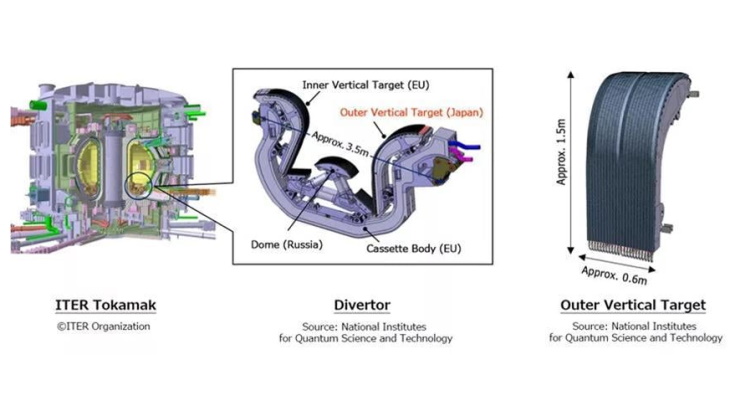Mitsubishi Heavy Industries (MHI) and Japan’s National Institutes for Quantum Science and Technology (QST) have successfully completed the prototype of an outer vertical target, a crucial component of the divertor for the International Thermonuclear Experimental Reactor (ITER).
MHI has announced its readiness to move into series production.
The Role and Components of the Divertor
The divertor is a fundamental component of the tokamak fusion reactor, tasked with removing helium ashes, unburned fuel, and other impurities from the core plasma produced by the fusion reaction.

It also handles high heat and particle loads, essential for maintaining stable plasma confinement.
The divertor is composed of four parts: the outer vertical target, which Japan is procuring; the cassette body and inner vertical target, produced in the EU; and the dome, manufactured in Russia.
Extreme Environment and Precision Requirements
The outer vertical target endures the harshest conditions, facing a heat load of up to 20 MWt per square meter.
Due to its direct exposure to plasma, it must withstand intense heat and high-energy particle loading.
Its complex structure demands high-precision fabrication and processing technologies.
Transition from Prototype to Production
MHI and QST have gained valuable technological expertise from producing the prototype, which they began manufacturing in June 2020.
This experience will be leveraged to manufacture the units for ITER, marking a significant contribution to the project’s advancement.
Contract for Additional Outer Vertical Targets
In May this year, MHI secured a contract from QST to supply 12 more outer vertical targets for ITER’s divertor.
This follows an initial order in 2021 for six units (Unit 1 – Unit 6). Including the additional 12 units (Unit 7 – Unit 18), MHI will produce 18 of the total 54 outer vertical targets.
QST will manufacture the remaining units. The production of these targets will be completed in stages, with deliveries to QST starting in 2026.
The ITER Project: A Collaborative International Effort
ITER is an ambitious international initiative aimed at constructing a tokamak fusion device in Cadarache, France, to demonstrate the feasibility of fusion as a large-scale, carbon-free energy source.
The objective is to achieve 500 MW of output (sustained for at least 400 seconds) with 50 MW of plasma heating power input, potentially requiring an additional 300 MWe of electricity input during operation. ITER itself will not generate electricity.
Global Collaboration and Project Timeline
Thirty-five nations are collaborating on the ITER project. The European Union is contributing nearly half of the construction costs, with the other six members—China, India, Japan, South Korea, Russia, and the USA—sharing the remainder equally.
Construction began in 2010, and although the initial first plasma target date of 2018 was postponed to 2025 by the ITER council in 2016, a revised project plan announced in June this year aims for a robust initial phase of operations, including deuterium-deuterium fusion by 2035, followed by full magnetic energy and plasma current operations.
In summary, the successful production of the prototype outer vertical target and the subsequent readiness for series production by MHI and QST mark significant milestones in Japan’s contribution to the ITER project, a landmark endeavor in the quest for sustainable, large-scale fusion energy.